Deception Island
| Deception Island | |
|---|---|
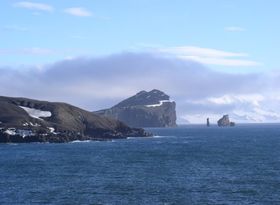 Entrance to Deception Island, with Livingston Island in the background. |
|
| Elevation | 576 m (1,890 ft) [1] |
| Prominence | 576 m (1,890 ft) |
| Location | |
| Location | Antarctica |
| Geology | |
| Type | Caldera |
| Last eruption | 1970 |
Deception Island is an island in South Shetland off the Antarctic Peninsula, which has one of the safest harbours in Antarctica. A recently active volcano in 1967 and 1969 caused serious damage to the local scientific stations. The only current research bases are run by Argentina and Spain.
Contents |
Geography
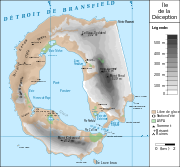 Map of Deception Island. |
|
 |
|
| Geography | |
|---|---|
| Location | Antarctica |
| Length | 12 km (7.5 mi) |
| Width | 12 km (7.5 mi) |
| Country | |
The island, located at , is approximately circular with a diameter of about 12 km (7.5 mi). A peak on the east side of the island, Mt. Pond, has an elevation of 542 m (1,778 ft), and over half the island is covered by glaciers. The centre of the island is a caldera formed in a huge (VEI-6) eruption which has been flooded by the sea to form a large bay, now called Port Foster, about 9 km (5.6 mi) long and 6 km (3.7 mi) wide. The bay has a narrow entrance, just 230 m (755 ft) wide, called Neptunes Bellows. Adding to the hazard is Ravn Rock, which lies 2.5 m (8.2 ft) below the water in the middle of the channel. Just inside Neptunes Bellows lies the cove Whalers Bay, which is bordered by a large black-sand beach.
Several maars line the inside rim of the caldera, with some containing crater lakes (including one named Crater Lake). Others form bays within the harbour, such as the 1 km (0.6 mi) wide Whalers Bay. Other features of the island include Mount Achala, Primero de Mayo Bay, Sewing-Machine Needles, Telefon Bay and Telefon Ridge.
History
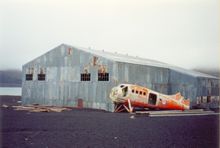
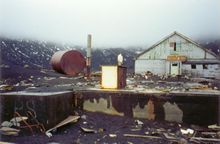
Since the early 19th century, Deception Island was a favourite refuge area from the storms and icebergs of Antarctica. It was first used by sealers. Then in 1906, a Norwegian-Chilean whaling company started using Whalers Bay as a base for a factory ship, the Gobernador Bories. Other whaling operations followed suit, and by 1914 there were 13 factory ships based there.
The station did not actually process whale blubber, which was done on the ships, but instead took the carcasses and boiled them down to extract additional whale oil, using large iron boilers, and storing the results in iron tanks.
Whale oil prices dropped during the Great Depression, making the station economically unprofitable, thus it was abandoned in 1931. Advances in factory ships made shore stations for carcass processing unnecessary, and so it was never reoccupied. Forty-five men were buried in the station's cemetery, but the cemetery was again buried in a 1969 volcano eruption, and the only remaining signs are the rusting boilers and tanks.
Other remains at Whalers Bay include an aircraft hangar with a bright orange derelict airplane fuselage outside (removed in 2004),[2] and the British scientific station house (Biscoe House), with the middle torn out by the mudflows in 1969.
In the 1940s and 1950s, Argentina contested control of Deception Island with the UK with some removals of the sovereign flag and temporary occupation of the island.
On 3 February 1944, the British established a permanent base on Deception Island as part of Operation Tabarin, and occupied it until 5 December 1967, when another volcanic eruption forced a temporary withdrawal. It was used again between 4 December 1968 and 23 February 1969, when further volcanic activity caused it to be abandoned.[3]
In 1955 Chile inaugurated its station Pedro Aguirre Cerda at Pendulum Cove, to increase the Chilean presence in the sector claimed by that nation.
In 1961 Argentina's president Arturo Frondizi visited to show his country's interest.
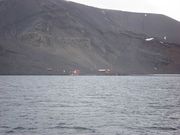
In 1963 the American Coast Guard icebreaker Eastwind WAGB 279 visited Deception Island. There were two scientific stations active, a British and a Chilean. The Chileans had an air strip and flew a DeHavilland Beaver back and forth to Punta Arenas for resupply. There were active fumaroles spewing noxious gases and some fumaroles had churning volcanic ash in the depressions. The Eastwind ran aground inside the volcano which is likely the only time an American military ship ever ran aground inside an active volcano. The ship refloated with the rising tide.
In 1969 a violent volcanic eruption demolished the Chilean stations Pedro Aguirre Cerda and Gutierrez Vargas. The volcano has mostly destroyed other attempts to maintain permanent facilities, and as of 2000, there were only two scientific stations still in use, both summer-only; Spain has the Gabriel de Castilla,[4] and Argentina has its Decepción Station.[2]
Ecology and micro climates
_43.jpg)
Deception Island has become a popular tourist stop in Antarctica because of its several colonies of chinstrap penguins, as well as the novel possibility of making a warm bath by digging into the sands of the beach. Baily Head on the west side of the island holds one of the world's largest chinstrap rookeries. Mount Flora is the first site in Antarctica where fossilized plants were discovered.[5]
After the Norwegian Coastal Cruise Liner MS Nordkapp ran aground off the coast of Deception Island on January 30, 2007, fuel from the ship washed into a bay. Ecological damage has not yet been determined. On February 4, 2007 the Spanish Gabriel de Castilla research station on Deception Island reported that water and sand tests were clean and that they had not found signs of the oil, estimated as 500 to 750 litres (130 to 200 USgal) of light diesel.
Deception Island exhibits some wildly varying microclimates. Some water temperatures reach 70 °C (158 °F). Near volcanic areas, the air can be as hot as 40 °C (104 °F).
See also
- List of Antarctic and sub-Antarctic islands
- List of Antarctic islands south of 60° S
- List of volcanoes in Antarctica
- South Shetland Islands
References
- ↑ "Deception Island". Global Volcanism Program, Smithsonian Institution. http://www.volcano.si.edu/world/volcano.cfm?vnum=1900-03=. Retrieved 25 December 2008.
- ↑ 2.0 2.1 "4 April - Otter Recovery". British Antarctic Survey. http://www.antarctica.ac.uk/living_and_working/diaries/rrs_ernest_shackleton/antarctic2003_2004/27/index.php. Retrieved 24 May 2009.
- ↑ Fuchs, Vivian (1982). Of Ice and Men. Oswestry: Anthony Nelson. pp. 291–2. ISBN 0904614069.
- ↑ "Gabriel De Castilla". New Zealand: Shades Stamp Shop. http://www.newzeal.com/theme/bases/Spain/gabrieldecastilla.htm. Retrieved 24 May 2009.
- ↑ Jurassic Liverworts from Mount Flora, Hope Bay, Antarctica
- Official Deception Island website. Accessed 3 May 2007.
- Volcanic Activity. Accessed 4 June 2007.
- Deception Island, Eco-Photo Explorers. Accessed 3 May 2007.
- LeMasurier, W. E.; Thomson, J. W.; et al. (1990). Volcanoes of the Antarctic Plate and Southern Oceans. American Geophysical Union. ISBN 0-87590-172-7.
External links
- Images from Deception Island
- Topographic map of Deception Island
- Página Web de la base Gabriel de Castilla
- "Steamed Ice and Frosted Lava" Account of a tourist visit to Deception Island
- British Deception Island station
- 21 photos of Deception island
- A visit to Deception Island, and other places on the Antarctic Peninsula, in 2002/3
|
|||||||||||